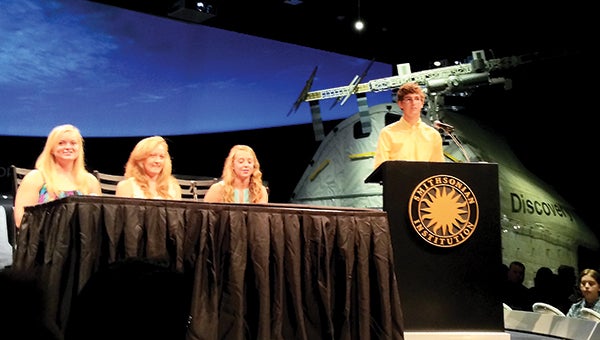The Sky’s No Limit: BA experiment launched into space
Published 10:29 am Friday, July 18, 2014

PHOTO SUBMITTED / Brookhaven Academy’s Ashlea Bardwell, (from left) Ruth Vaughan, Lindsey Winborne and Garrett Smith present at a National Center for Earth and Space Science Education conference held at the Smithsonian in Washington, D.C., July 2.
Four students from Brookhaven Academy recently traveled to Washington, D.C., to present research proposals at the Smithsonian. Then their experiment launched this week on Sunday and attached to the International Space Station Wednesday.
The team, comprised of Ashlea Bardwell, Samantha Barton, Garrett Smith, Ruth Vaughan and Lindsey Winborne, have conducted research involving the bacterium Ralstonia eutropha and its production of polydyroxyalknanoates, a biodegradable plastic.
Smith said the group wanted to focus on medical purposes. Winborne said they originally had hoped to do an experiment with Lorenzo’s Oil, an experimental treatment for those with ALD not yet showing symptoms. ALD is a form of dystrophy that most severely affects central nervous system tissues. However, because of the need for human samples, the team realized it would not be feasible.
Winborne said while doing preliminary research on Lorenzo’s oil they came across the bacteria and decided to focus their research on it.
The PHA produced can be used for sutures, valve replacements and skin grafts.
Vaughan said the focus of their experiment is to determine how the production of PHA is affected by microgravity. Winborne said it could help reduce medical costs by allowing the plastic to be produced in space instead of being sent from Earth.
Vaughan said she was surprised by the number of different types of things bacteria can produce to help people.
Winborne learned the necessity for being careful while setting up an experiment.
“It’s so easy to get contaminated,” she said.
Vaughan said it takes about two weeks for the PHA granules to be developed on Earth. Smith said they traveled to the University of Mississippi Medical Center to conduct their experiments.
Leslie Hood, one of the teachers who helped mentor the students, said the process began as students in from fourth grade to 12th grade submitted proposals to the National Center for Earth and Space Science Education. The BA group went through a peer review process at their own school before submission.
Then NCESSE had a group of scientists then choose the top three proposals, which are then subjected to a secondary peer review. The winners were then able to have their experiment sent to the International Space Station.
All students said their favorite aspect of the program was to present at the Smithsonian.
“My favorite part was being able to present it in front of all these doctors,” Vaughan said.
Smith expects to program to help his future endeavors in the medical field.
“Actually presenting research at a national organization, like the Smithsonian, really sets me apart,” he said.
Bardwell said the opportunity was unique.
“It was really fun,” she said. “I was excited to have the experience.”

